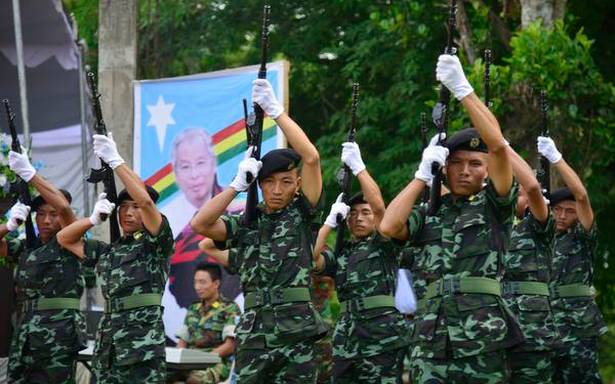What is the status of Naga peace talks? Is the stalemate over NSCN(I-M) demanding a separate flag and constitution?
The story so far: On December 4, six villagers returning from a coal mine were killed in an operation by para commandos in Nagaland’s Mon district. Seven more were killed in Army firing after protests broke out. Home Minister Amit Shah told Parliament on Monday that it was a case of “mistaken identity.” Nagaland and Naga-inhabited areas in neighbouring States saw a shutdown on Monday with a strong demand to repeal the Armed Forces (Special Powers) Act or AFSPA, which gives unbridled power to the armed forces to conduct operations.
Will the incident impact ongoing talks?
The Government is engaged in discussions with the Isak-Muivah faction of the National Socialist Council of Nagaland (NSCN-IM) and seven Naga National Political Groups (NNPGs) to find a solution to the Naga political issue. The Isak-Muivah faction, the key player in the Naga peace talks, described the incident in Mon as a “black day” for Nagas.
The NSCN-IM, one of the largest Naga groups, has been demanding ‘Greater Nagaland’ or Nagalim, an extension of Nagaland’s borders by including Naga-dominated areas in neighbouring Assam, Manipur and Arunachal Pradesh and uniting 1.2 million Nagas. The Centre has said there will be no disintegration of the States of Assam, Arunachal Pradesh and Manipur to merge Naga-inhabited areas with the existing State of Nagaland. More than hundred rounds of talks spanning over 24 years have taken place so far. The NSCN(I-M) first signed a ceasefire agreement in 1997. The group was formed in 1980 to oppose the Shillong Accord signed by the then Naga National Council (NNC) with the Central Government to bring peace in Nagaland.
What was signed in 2015?
A year after the Narendra Modi led BJP Government came to power, the NSCN(I-M) group signed a framework agreement on August 3, 2015 to end the decades-old Naga strife. The then Joint Intelligence Chief and interlocutor for Naga peace talks, R.N. Ravi, signed the agreement on behalf of the Centre and was later appointed as Nagaland’s Governor in 2019. The move was seen as an effort to steer the Naga talks to a conclusion. In 2020, the NSCN(I-M) demanded the removal of Mr. Ravi accusing him of “high handedness” and tweaking the agreement to mislead other Naga groups. Home Minister Shah then roped in Assam Chief Minister Himanta Biswa Sarma and two IB officers to continue the negotiation . One of the officers, A.K. Mishra, who retired as special director last year, was appointed as an adviser in the Home Ministry to continue the talks.
THE GIST
- The killing of 13 civilians by the Armed forces in Nagaland have put the spotlight back on the stalemate between the NSCN-IM and seven NNPGs with the Union of India.
- The NSCN-IM has been demanding ‘Greater Nagaland’, an extension of Nagaland’s borders by including Naga-dominated areas of neighbouring States. Multiple rounds of talks have taken place so far. Finally, a framework agreement was signed on August 3, 2015 to end the decades-old Naga strife.
- In 2020, the NSCN(I-M) alleged that the original agreement was tweaked to mislead other Naga groups which resulted in a breakdown of talks.
Why is there a stalemate?
After inking the framework with the NSCN(I-M), Mr. Ravi signed a preamble in November 2017 with the NNPGs and made them a party in the Naga peace deal.
Following the breakdown of talks with Mr. Ravi, the NSCN(I-M) for the first time on August 11, 2020, released the details of the 2015 framework agreement, till then a secret document. It accused Mr. Ravi of deleting a key word from the original document and sharing the modified version with other Naga groups. The agreement released by the group talked about “sharing the sovereign power” and provide for an “enduring inclusive new relationship of peaceful co-existence of the two entities.” It claimed that Mr. Ravi, “craftily deleted the word ‘new’ from the original” to justify his own narrative. The NSCN(I-M) said the word ‘new’ is politically sensitive as it goes to define the meaning of peaceful co-existence of the two entities (two sovereign powers). The group has been demanding a separate flag and a constitution. The framework agreement said, “Both sides have understood each other’s respective positions and are cognisant of the universal principle that in a democracy sovereignty lies with the people. Accordingly, the Govt. of India and the NSCN, respecting people’s wishes for sharing the sovereign power as defined in the competencies, reached an agreement on the 3rd August, 2015 as an honourable solution.” The NSCN(I-M) said Mr. Ravi insulted them when he reportedly told them that “this can be understood even by Class VII students that it means acceptance of the Indian Constitution”. In June 2020, Mr. Ravi had also written to Nagaland Chief Minister Neiphiu Rio that “over half a dozen organized armed gangs were brazenly running their respective ‘so called governments’ challenging the legitimacy of the State Government.” Mr. Ravi resigned as interlocutor on September 22, a few days after he was appointed as Tamil Nadu Governor. He continues to advise the Government on Naga talks.
Mr. Mishra continues the dialogue with the NSCN(I-M), NNPGs and the other stakeholders.The hushed negotiations have not been made public but it is understood that there is a stalemate on the NSCN(I-M)’s demand for a separate flag and constitution. A working member of the NNPG told The Hindu, “We have conveyed all our demands to the Government of India, the delay is at their end. They have to come up with a solution.”
Source: Read Full Article

